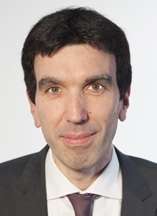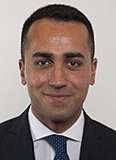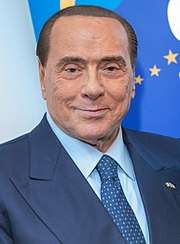European Parliament election, 2019 (Italy)
|
| |||||||||||||||||||||||||
| |||||||||||||||||||||||||
All 76 Italian seats to the European Parliament | |||||||||||||||||||||||||
|---|---|---|---|---|---|---|---|---|---|---|---|---|---|---|---|---|---|---|---|---|---|---|---|---|---|
| |||||||||||||||||||||||||
The 2019 European Parliament election in Italy will be held on 26 May 2019, electing members of the 9th Italian delegation to the European Parliament as part of the European elections held across the European Union.
Electoral system
The party-list proportional representation was the traditional electoral system of the Italian Republic since its foundation in 1946, so it had been adopted to elect the Italian representatives to the European Parliament too. Two levels were used: a national level to divide seats between parties, and a constituency level to distribute them between candidates. Italian regions were united in 5 constituencies, each electing a group of deputies. At national level, seats were divided between party lists using the largest remainder method with Hare quota. All seats gained by each party were automatically distributed to their local open lists and their most voted candidates.
In the run-up of the 2009 election, the Italian Parliament has introduced a national threshold of 4% in the electoral law for the European Parliament. However, the electoral law guarantees representation for linguistic minorities. The parties which represent minorities can be connected with the major parties for the purpose of elections, combining their votes. If the party of the linguistic minority gets more than 50,000 votes, it wins a seat.
Background
In 2014 the governing Democratic Party (PD) of Prime Minister Matteo Renzi won the election with 40.8% of the vote and 31 seats, followed by the Five Star Movement (21.2% and 17 seats) and Forza Italia (16.8% and 13 seats). As a result, the PD was the second largest national party in the European Parliament by number of seats after the German CDU/CSU and the largest among the Progressive Alliance of Socialists and Democrats.[1] The PD's score was also the best result for an Italian party in a nationwide election since the 1958 general election, when the Christian Democracy won 42.4% of the vote.
However in December 2016, after less than three years from the 2014 electoral landslide, Renzi was forced to resign after the defeat in the constitutional referendum, in which he aimed to abolish the Senate, and his foreign affairs minister, Paolo Gentiloni, was appointed new head of government.[2][3] Moreover the 2018 general election was characterized by a strong showing of populists parties. The centre-right coalition, led by Matteo Salvini's right-wing League, emerged with a plurality of seats in the Chamber of Deputies and in the Senate, while the anti-establishment Five Star Movement led by Luigi Di Maio became the party with the largest number of votes; Renzi's centre-left came only third, with the worst electoral result of its history.[4][5] However, no political group or party won an outright majority, resulting in a hung parliament.[6]
After three months of negotiation, a coalition was finally formed on 1 June between the M5S and the League, whose leaders both became Deputy Prime Ministers in a government led by the M5S-linked independent Giuseppe Conte as Prime Minister.[7][8]
Parties and leaders
This is a list of the main active parties which would likely participate in the election and are polled in most opinion surveys.
| Party | Ideology | Leader | Alliance | Current MEPs | |
|---|---|---|---|---|---|
| Democratic Party (PD) | Social democracy | Maurizio Martina | S&D | 26 / 73 | |
| Five Star Movement (M5S) | Populism | Luigi Di Maio | EFDD | 14 / 73 | |
| Forza Italia (FI) | Liberal conservatism | Silvio Berlusconi | EPP | 12 / 73 | |
| League (LN) | Right-wing populism | Matteo Salvini | ENF | 6 / 73 | |
| Free and Equal (LeU) | Social democracy | Pietro Grasso | S&D GUE–NGL |
6 / 73 | |
| Us with Italy (NcI) | Christian democracy | Raffaele Fitto | ECR | 2 / 73 | |
| Power to the People (PaP) | Communism | Viola Carofalo | GUE–NGL | 1 / 73 | |
| Brothers of Italy (FdI) | National conservatism | Giorgia Meloni | None | 0 / 73 | |
References
- ↑ Renzi's triumph in EU vote gives mandate for Italian reform
- ↑ @lex_sala. "Referendum costituzionale 2016 Il No al 60%, la riforma non passa Renzi: «Ho perso io, mi dimetto". Corriere.it. Retrieved 2016-12-05.
- ↑ "Paolo Gentiloni, Italian foreign minister, appointed PM". BBC News. 11 December 2016.
- ↑ "Elezioni politiche: vincono M5s e Lega. Crollo del Partito democratico. Centrodestra prima coalizione. Il Carroccio sorpassa Forza Italia". 4 March 2018.
- ↑ Sala, Alessandro. "Elezioni 2018: M5S primo partito, nel centrodestra la Lega supera FI".
- ↑ Italy election to result in hung parliament
- ↑ "Governo, Conte accetta l'incarico e presenta la lista: 18 ministri, 5 le donne. Tria all'Economia". 31 May 2018. Retrieved 2 June 2018.
- ↑ "Nasce il governo Conte. Presentata a Mattarella la lista dei ministri. Di Maio e Salvini vicepremier". RaiNews (in Italian). 1 June 2018. Retrieved 1 June 2018.


